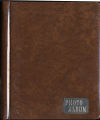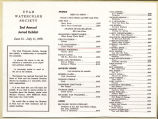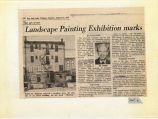| OCR Text |
Show 6-E. The Salt Lake Tribune, Sunday, November 14, 1976 *â- ' Watercolors recall U. history By George Dibble Watercolors at the Public Library and drawings in the University of Utah School of Architecture by. Roger Bailey recall some campus history. Professor Bailey organized the department of architecture during the period of explosive growth when burgeoning enrollment following World War II placed a heavy strain on physical facilities. The campus soon expanded to areas previously occupied by the military and classes were being held in almost anything that had four sides and a roof. Professor Bailey left a position at the University of Mr. Dibole Michigan to organize a department here and with Three Elements "Sea Ranch Country" is grouped in three elements with an engaging eye path moving to the right. The pattern of Vertical trees is rhythmically correlated to land contours and the organic sense of these forms is carried throughout. A modulated and well keyed palette subordinates color to essential movements and even in higher ranges there is udieious restraint. Emphasis on major formal shapes is relieved with impeccable attention to detail in leaf pattern, surf edge or subtle rock contours. Valoy Eaton's new exhibit of oils and watercolors at the Stable Gallery had not been completely assembled at this writing, but I was especially interested in a large oil, "BB Gun". The artist could have drawn from any number of locations â€" Manti, Magna Hyrum â€" for the setting of this carefree summer theme. Two youths are plinking at objects with an air gun along a small creek running through any town in the intermountain region. It is effulgent summer at its height â€" far enough from classroom drudgery to be appreciated by the erstwhile scholars in the painting. Pigments invested in the warming tenor of the theme are relieved by cool tree and feneeline opposed by a hot sky. For anyone with a similar experience, however far removed, who recalls a quiet stream running through peaceful meadows, it can be a recall of one of the good-to-be-alive times which seems ever improved with nostalgia. One of the paintings in Ken Baxter's exhibit at Barnes Banking Co. in Kaysville, explores the idea of moppets ready for a tubing party, there is the feeling of anticipation, insousciance, childlike enthusiasm and good humor. The exhuberant tones of brightly colored clothing aids the mood, but simplified concern is with the all important outing. Members of Southern Utah State College's art staff are represented in a faculty exhibition of painting, sculpture, weaving, ceramics and jewelry in the Braithwaite Gallery. Represented are Carol Jeanne Abraham, Glen Dale Anderson, Carmen Jones, Thomas Leek and Mary McDonald. Gallery hours are 10 a.m. to 5 p.m. Monday through Friday \ and 1 to 6 p.m. Saturday. / added enroliees and a handful of students transferring from the phased out program at Denver University, began operations in a mess hall and PX left over from the first World War on the arnica weed flats at the northeast corner of the present campus. With the moving of six two-storied army barracks into the area, Fine Arts Alley came into being flanked by the departments of art and architecture. The latter boasted classrooms, studios, offices, a small exhibition space and an informal garden between the barracks. On the art side, four barracks and a row of brick latrines became classrooms, studios, offices and a library. , The street between, never very wide, was even less divisive with a sharing of eurrieular offerings. Bailey, a skilled Tenderer and aquarellist encouraged student architects to add performance skills in related arts to their programs. Many took classes in ceramics, painting and life drawing. A number.oJt them, Frank Ferguson, Paul Bowjen,^^^a^J^^ ' fefs, Paul EUingson^HojgeiJDay^j|idjgtttelCS .gained professional r<:cognMffltt__m2d^ajraig^_^myn^SDd ceramics. Excellent Administrator Professor Bailey was an excellent administrator, building a strong staff and student complement. The rigors of academic life in architecture are well known. Provident areas of lawn in the complex offered needed relief from the academic grind. Volley ball and touch football usually kept the grass trimmed. On an afternoon late in March when wet snow had blanketed the center, a fourth-year student reached out of an upstairs drawing studio onto the adjacent roof to mold some of the cool flakes. It was planted neatly between the shoulders of a figure below. The gesture returned smartly, set off a snow flinging ruckus that raged around buildings and rooftops. With the inevitable tinkle of broken glass a panicky informant called Building and Grounds. An excited voice on the phone to the department head brought a calming response â€" the situation was not unreasonable, entirely controllable and incident damage would be properly accounted for. Minutes later the area was as quiet as a ball park in December. Skillful management of a facile medium can be appreciated in the group of paintings at the Library. Professor Bailey, living /in Carmel, California, employs the vigorous coastline and fog mists of Northern California for deftly rendered subject matter. They are classics in the landscape sense. Design quality is paramount to visual reporting although there is an essential feeling of location. â- I |

























